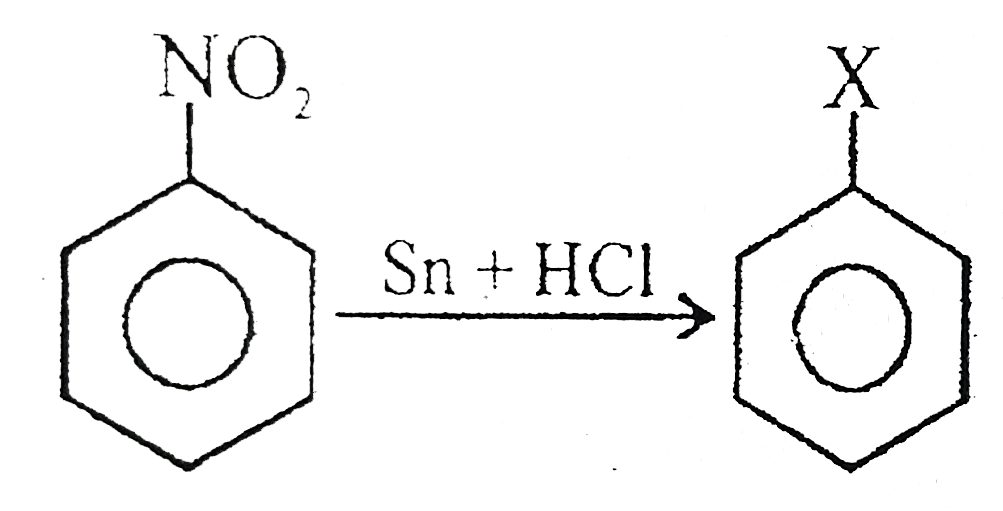I2+KI→KI3
In the above reaction :-
Only oxidation taken place
Only reduction takes place
Both the above
None of the above
The correct Answer is:C
To analyze the reaction I2+KI→KI3 and determine whether it involves oxidation, reduction, or both, we can follow these steps:
Step 1: Write the Reaction
The reaction is given as:
I2+KI→KI3
Step 2: Assign Oxidation States
- In I2, the oxidation state of iodine (I) is 0 because it is in its elemental form.
- In potassium iodide (KI), potassium (K) has an oxidation state of +1 and iodine (I) has an oxidation state of -1.
- In potassium triiodide (KI_3), we need to calculate the oxidation state of iodine in this compound.
Step 3: Calculate the Oxidation State of Iodine in KI_3
The formula for KI_3 consists of one potassium ion (K) and three iodine ions (I). The overall charge of the compound is neutral (0).
Let the oxidation state of iodine in KI_3 be x:
1⋅(+1)+3⋅x=0
This simplifies to:
1+3x=0
3x=−1⇒x=−13
Step 4: Compare Oxidation States
- The oxidation state of iodine changes from 0 in I2 to -13 in KI3.
- The oxidation state of iodine in KI is -1.
Step 5: Identify Oxidation and Reduction
- The change from 0 to -13 indicates a reduction (gain of electrons).
- The change from -1 to -13 indicates an increase in oxidation state, which is oxidation (loss of electrons).
Conclusion
Since both oxidation and reduction processes are occurring in this reaction, we conclude that both are happening.
Final Answer
Both oxidation and reduction are occurring in the reaction I2+KI→KI3.
The reaction is given as:
I2+KI→KI3
- In I2, the oxidation state of iodine (I) is 0 because it is in its elemental form.
- In potassium iodide (KI), potassium (K) has an oxidation state of +1 and iodine (I) has an oxidation state of -1.
- In potassium triiodide (KI_3), we need to calculate the oxidation state of iodine in this compound.
The formula for KI_3 consists of one potassium ion (K) and three iodine ions (I). The overall charge of the compound is neutral (0).
1⋅(+1)+3⋅x=0
This simplifies to:
1+3x=0
3x=−1⇒x=−13
- The oxidation state of iodine changes from 0 in I2 to -13 in KI3.
- The oxidation state of iodine in KI is -1.
- The change from 0 to -13 indicates a reduction (gain of electrons).
- The change from -1 to -13 indicates an increase in oxidation state, which is oxidation (loss of electrons).
Since both oxidation and reduction processes are occurring in this reaction, we conclude that both are happening.
Both oxidation and reduction are occurring in the reaction I2+KI→KI3.
Topper's Solved these Questions
- REDOX REACTIONSBOOK - ALLENCHAPTER - REDOX REACTIONSEXERCISE - EXERICSE - 3
30 Videos
- REDOX REACTIONSBOOK - ALLENCHAPTER - REDOX REACTIONSEXERCISE - EXERICSE - 4
27 Videos
- REDOX REACTIONSBOOK - ALLENCHAPTER - REDOX REACTIONSEXERCISE - Exercise - 1
61 Videos
- Redox Reaction BOOK - ALLENCHAPTER - Redox Reaction EXERCISE - All Questions
19 Videos
- s-Block element BOOK - ALLENCHAPTER - s-Block element EXERCISE - All Questions
14 Videos
Similar Questions
Knowledge Check

In the above reaction, product (B) is :A B
B C
C D
D

Product (B) in the above reactions is:A B
B C
C D
D

In the above reaction 'X' stands for
View Solution
In the above reaction 'X' stands for
View Solution
Produtc P in the above reaction is
View Solution The above reaction is known as
The above reaction is known as
View Solution
The above reaction is known as
View SolutionCH2=CH2HBr−−→XAg.KOH−−−−−→YNa2CO3−−−−→I2Z. In the above reaction sequence, Z is :
View Solution


 In the above reaction, product is
In the above reaction, product is